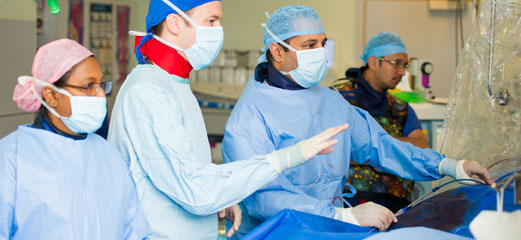
What is heart catheterisation?
This is a procedure to diagnose or treat a heart condition, although echocardiography can in most instances provide a diagnosis. Catheters can provide additional information like direct pressure measurements within the heart and vessels and can add further details to the diagnosis established by echocardiography and magnetic resonance imaging (MRI).
Most of the catheterisations we carry out are procedures (known as catheter interventions) to treat a condition, such as:
- device closure of atrial and ventricular septal defects
- closure of persistent arterial ducts
- dilatation of narrow valves and vessels
- stent implantations
- valve implantation.
You can read more information about different heart conditions and standard treatment options, and get further details from the Children's Heart Federation website.
The procedure
A catheterisation involves placing a small plastic tube (the catheter) into one of the big blood vessels of the body (usually the groin, but sometimes from the arm or neck) and passing up to the heart. From here, we can get information about the blood flow and pressures in the different parts of the heart and blood vessels.
We may use a contrast agent (dye) to show us details. We can also use specialised equipment such as balloon catheters and stents to treat your child's heart condition.
Up to 10 people may be involved in the procedure.
The process
- Your child will typically be given a general anaesthetic and cared for by an anaesthetist and an anaesthetic nurse.
- A cardiac technician will perform checks such as blood pressure measurements and blood gas analysis.
- A scrub nurse will help the cardiologist (doctor who specialises in heart problems) to have all the catheters and wires ready when needed.
- Radiographers will help to optimise the quality of images taken and take care of the radiation used in the procedure.
More complex cases may need more than one cardiologist. Professor Qureshi, Professor Rosenthal and Dr Jones work together as a team. Our dedicated nurse practitioner, Soodevi Boolkah is also involved in many cases and coordinates the supply for the complex procedures.
In some cases we may need to perform a catheterisation and surgery at the same time. This is called a hybrid procedure and is used to treat very complex congenital heart disease, especially in very small children. We perform an increasing number of these procedures, and have performed the highest number of these interventions on selected patients with hypoplastic left heart syndrome. Our centre is developing this service further for various conditions.
Our catheter laboratory
The catheter laboratory at Evelina London Children’s Hospital was installed in 2005 and completely refurbished in 2015. Using the most up-to-date technology allows us to get as much information as possible to plan your child’s care.
The cath lab is also used to carry out electrophysiological studies (EP studies), which can identify an abnormality that is causing heart rhythm disturbances. In many cases it is possible to treat this abnormality during the catheterisation. Professor Rosenthal diagnoses and treats several types of rhythm disturbances with the help of specialised equipment.
We carry out about 400-450 heart catheterisations every year.
Additional imaging may also be carried out to help diagnose and treat your child: